One of common religious act among Japanese
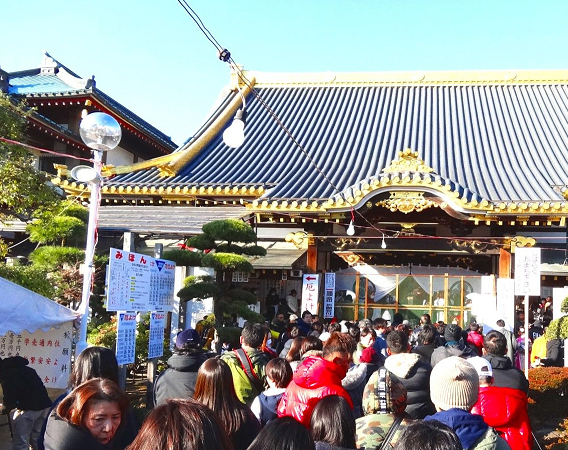
Many of Japanese, who are at certain period of years, “YAKU-DODHI厄年”, go to Buddhist temples or Japanese Shinto shrines to receive “KITO祈祷, the prayer service”, to ward off their bad luck or to avoid problems to be happened to them. This custom is traditionally believed in Japan. (Please refer to “YAKU-DOSHI厄除け and “YAKU-YOKE厄除け”). Not only within YAKU-DOSHI厄年 period but at some life-stage event such as wedding, birth of child, Shichi-Go-San1( seven-years, five-years, three-years), Japanese go to Buddhist temples or Shinto shrines to receive KITO祈祷,the prayer service, for their happiness, good health or others. Praying at temples or shrines of Japanese can be seen also at occasions of HATSUMOUDE (first visit of the year to the temples or shrines), before the time of entering examination of school, when they set any target to challenge, or if people repeatedly meet with misfortunes. KITO祈祷 is the rituals of Buddhism or Shinto to make people’s wishes come true by the power of Buddha or Japanese gods.
History
So what is more about KITO祈祷? As I am serving for the Buddhist temple, Sensoji, in TOKYO, here is the case of Buddhism ritual there.
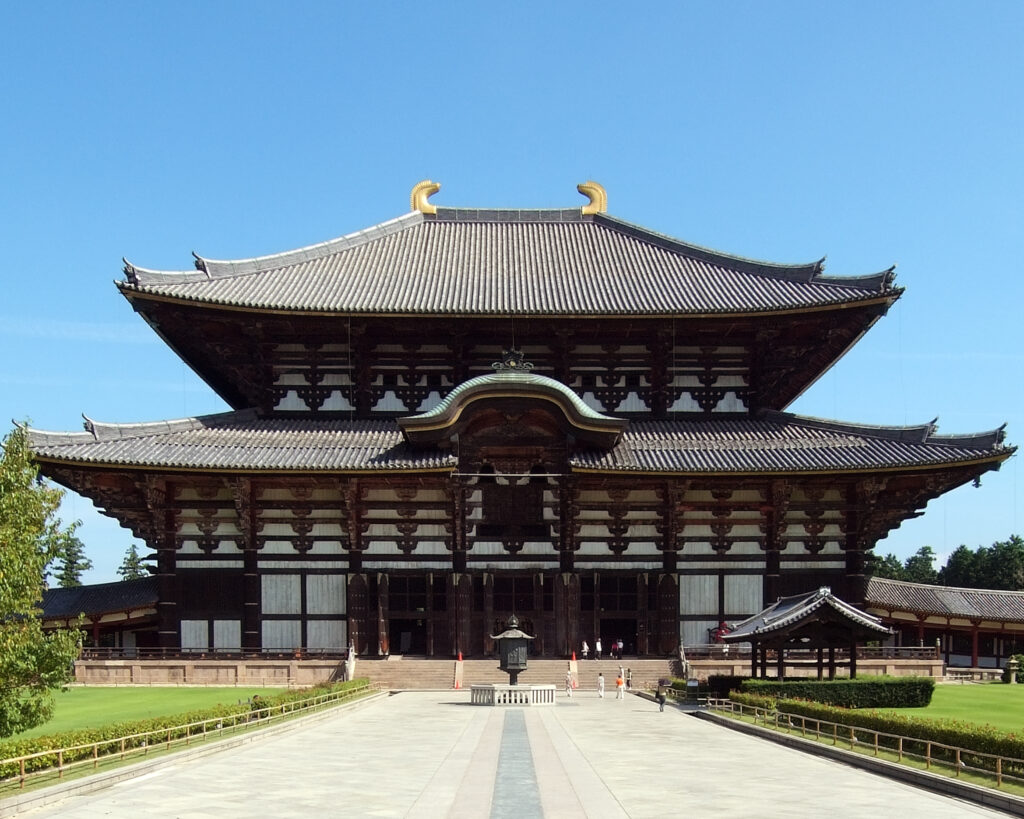
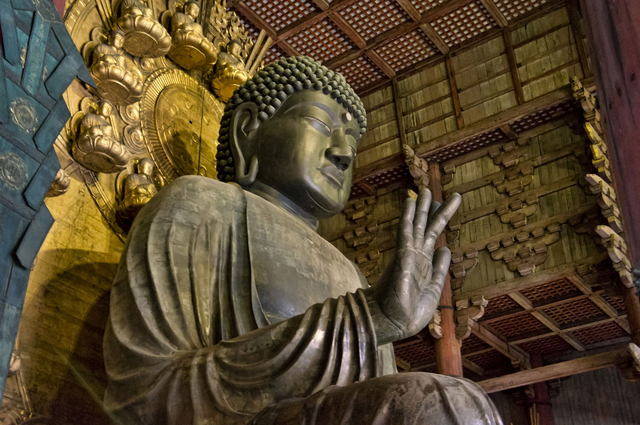
Buddhist ritual of KITO祈祷,prayer, has long history in Japan and is considered to be established in the late ASUKA Era (AC 592 to 710) after long political controversy between two key clans, one was for new Buddhism introduced from China in 538 and the other was for Japan’s traditional religion of gods, for about one hundred years. Finaly Buddhism became the key religion together with Japan’s traditional religion of gods, and in 752 the emperor Shoumu built the DAIBUTU大仏(The great Buddha) of TODAIJ東大寺 in NARA by conducting Buddhist KITO祈祷 prayer for national peace and for abundant harvest, it was the one of the biggest state rituals of KITOU since Buddhism introduced.
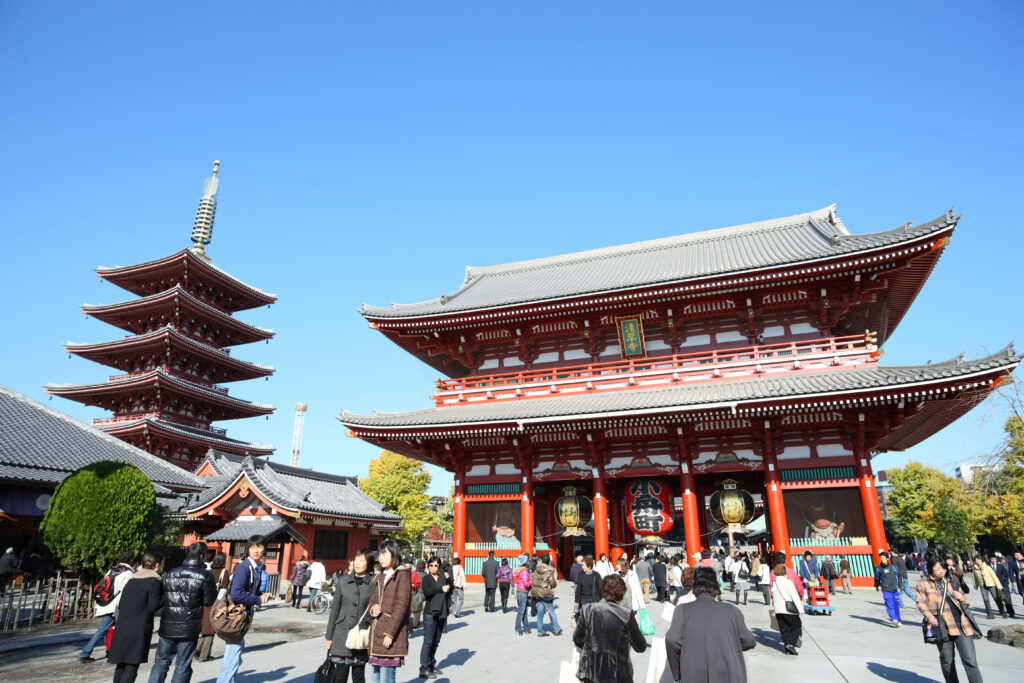
In the Heian Era (from end 8th century to late 12th century) KITO祈祷ritual became popular among aristocratic society, praying for not occurring disasters or famines, for personalized wish such as relieving illness. In Kamakura era ( end 12th century to 1333), the age of Samurai government, the first shogun of Kamakura Bakuhu2, Minamoto no Yoritomo, had made a prayer at SENSOJI浅草寺 for winning against Taira’s family at Dannoura battle before seizing the power. Tokugawa Ieyasu, the first Shogun of Tokugawa Bakuhu3, appointed SENSOJI浅草寺 to be the official prayer temple for its family. In this peaceful EDO era starting from 1603 for more than two hundred years, not only noble and samurai of the higher society but also ordinary people such as farmer and merchant could be able to go to the big shrine such as ISE-JINGU(called OISE-MAIRI ; visiting Ise-Jingu Shrine) and other famous temples in big cities for praying of their happiness and prosperity, due to the well-construction of road between Edo and other large cities.
The case at SENSOJI, Asakusa
There are several steps before, within and after the KITO祈祷 as follows.
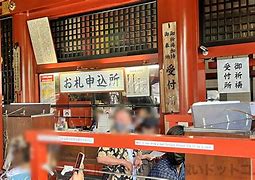
- content of wish : you need to decide one wish to be prayed
- amount of donation : you need to pay as a prayer’s fee
- application form : fill the name and wish, amount of donation
- attend the ceremony of prayer
- the talisman : after the ceremony the talisman is given
- bring the talisman to home and enshrine it.
Content of wish
Sendsoji, or another temples provide the list of wish. All you need to do is select one from the list. If you cannot find the one which does not match to your thought, you may consult temple’s staff.
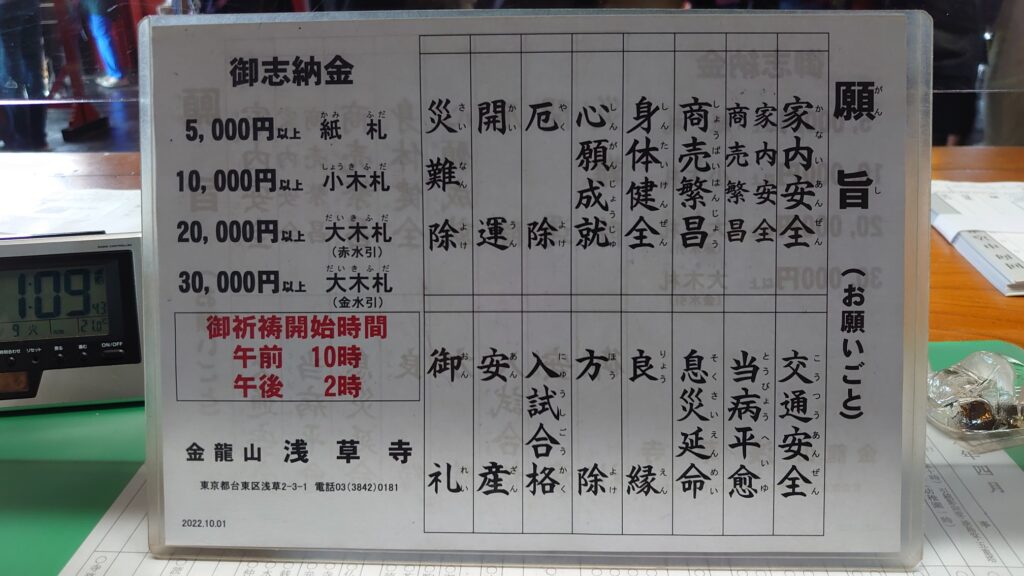
| 家内安全 | Family safety | 商売繁盛 | Business prosperity |
| 身体健全 | For healthy body and soul | 心願成就 | For realization of wishes |
| 厄除 | To ward off unluck | 開運 | For bringing good luck |
| 災難除 | For avoiding problems | 交通安全 | For safe transportation |
| 当病平癒 | For recovering illness | 息災延命 | For longevity of life |
| 良縁 | For finding good partner | 入試合格 | For passing examination |
| 安産 | For easy delivery | 御礼 | Appreciation to Buddha |
Donation as a fee of the prayer service
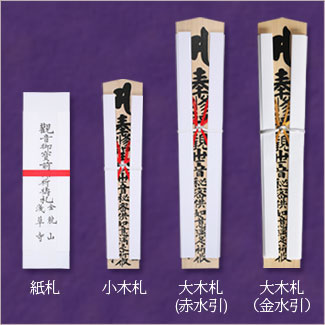
The fee of the prayer service is not fixed but with minimum 5000 Japanese Yen. The size and shape of ”祈祷札 Kitou-Fuda, talisman”, differs depending on the amount. The wish and your name are stated.
Fill in the application form
As the application form is in only Japanese, you need to ask the staff how you can fill in or ask them to fill in for you. But it is simple that you need to do is to write your name and select your wish from the list prepared.
Ceremony of prayer
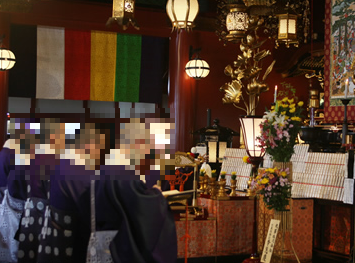
Sensoji conducts the KITO祈祷 ritual, to make the wishes fulfilled by chanting sutra to its principal image of the temple, 観世音菩薩 Avalokitesvara Boddhisattva so called KANNON, in observance of the ceremonials manners having been succeeded for more than a thousand years by Tendai sect of Buddhism. As the length of ritual is about 20 to 30 minutes, you are advised to attend so you can know how the Japanese Buddhism ritual is going on.
Talisman 祈祷札
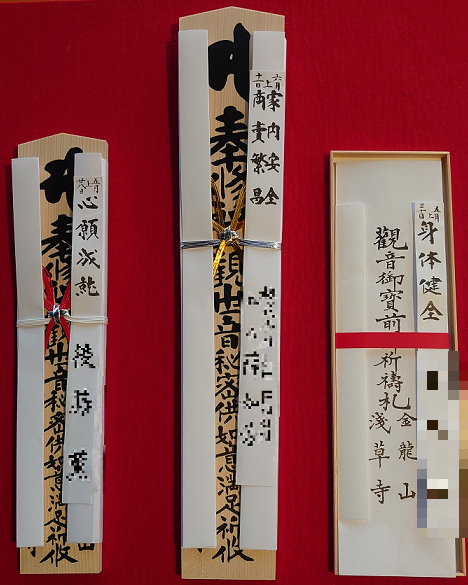
After the ritual, the applicants who asked prayer service receive the talisman designed by the creed of the Tendai sect and in which the soul of 観世音菩薩 Avalokitesvara Boddhisattva embedded
Bring back your talisman to home
You bring the talisman back to your home and enshrine it. BY enshrining the talisman at home, you may be comfortable to feel to be guarded by Bodhisattova KANNON letting your wish been realized.
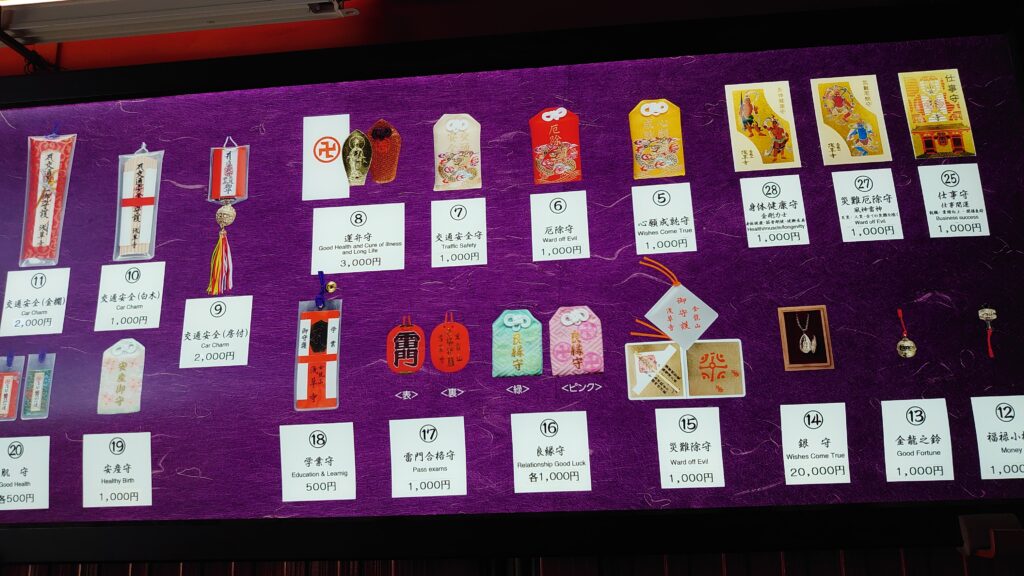
Actually, many of Japanese go to the SENSOJI 浅草寺 to pray for their hope to be realized and enshrine the talisman afterward as they think they can be always with a divided soul of KANNON観世音菩薩 indwelled in the talisman. Or even in case of not doing KITOU祈祷、people obtain the amulet which is relatively inexpensive and portable but still Budda’s power enclosed.
Japanese is religious
As I explain in the MUKUJI, few Japanese recognize themselves as Buddhist by the findings of survey, but actually their behaviors do show that they look very religious of Buddhist or Shinto practitioners. Japanese always put their hands together to show their respect to Buddha or God in front of, or before entering to Buddhist temples or Shinto shrines.
While Prof. Hiroshi Nakayama of Tukuba Univ. describe such behavior of Japanese as “light religion” (https://www.jstor.org/stable/48686686). , I , as a Japanese observing neighboring people, still believe that Japanese is quite religious nationals.
- The event that when boys are three and five years old and girls who are three and seven years old , they go to Buddhist temple or Shinto shrine to receive the prayer service, KITO祈祷, to thank and pray for their happy future ↩︎
- the Shogunate government led by Minamoto-no-Yoritomo and his successors lasted until 1333. ↩︎
- The Shogunate government led by Tokugawa Ieyasu and his descendants last until 1865. ↩︎
Welcome your recommendation of the theme for next!
I may overlook some ordinary action which impress you or let you feel different, so if you want to know about any Japanese behavior or actions which make you interesting, please let me know. I try to analize and post the story in this site.

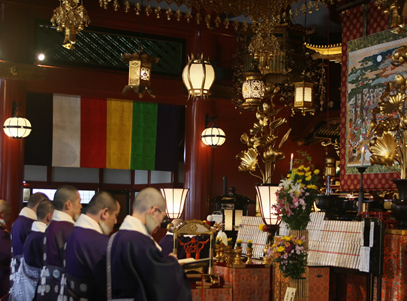
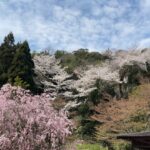
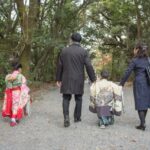
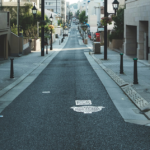
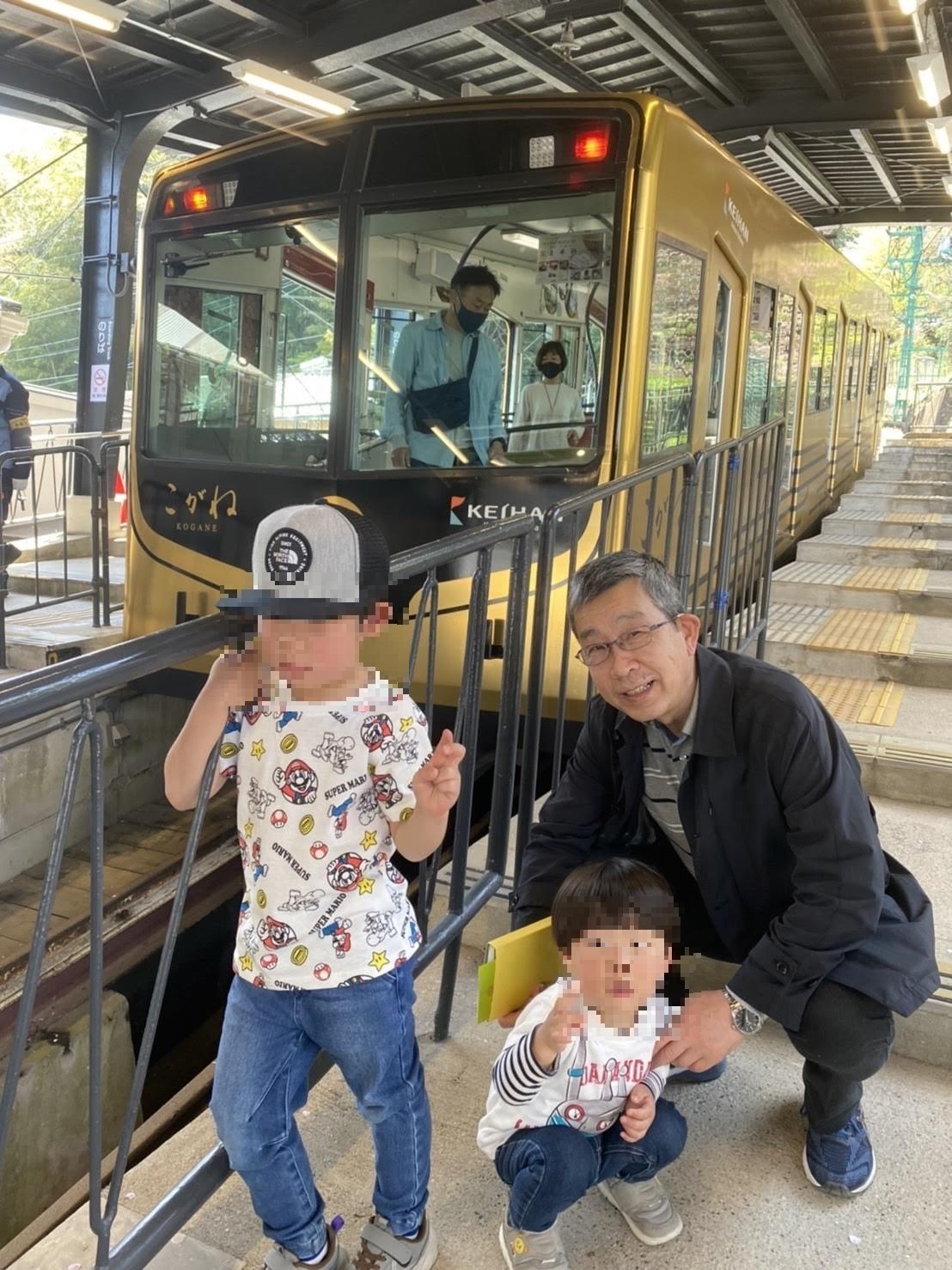


コメント